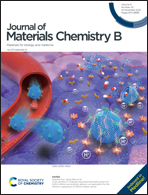A four-in-one pure nanomedicine for synergistic multi-target therapy against breast cancer†
Abstract
Designing a multi-target nanomedicine without a carrier is pivotal for successful cancer nanotherapy. This study details a novel four-in-one RRX/BMS/CA4/PTX nanomedicine by simple nanoprecipitation. In this multi-target pure nanomedicine, paclitaxel (PTX) causes the immunogenic cell death of 4T1 tumour cells and the differentiation of marrow-derived suppressor cells (MDSCs) into dendritic cells (DCs) at low dose; repertaxin (RRX) selectively depletes cancer stem cells (CSCs) that are not killed by paclitaxel to inhibit lung metastasis from the breast; BMS-1 blocks the PD-1/PD-L1 pathway for proliferating effector T cells; and combretastatin A4 (CA4) targets tumour microvessels to cut off the blood supply in the tumour microenvironment. The synergy of multi-target therapies results in excellent antitumour effects. The tumour inhibition rate of 4T1 tumours is 92.5%, and the lung metastasis suppression rate exceeds 90%; no relapse is observed at 46 days after the treatment endpoint, and the survival of 50% of mice is prolonged by 95 days. Due to the low dose of PTX administration, the systemic toxicity of the RRX/BMS/CA4/PTX nanomedicine is not found. Our results suggest a strategy for designing multi-target pure nanomedicines with simple construction and efficacious therapeutic responses that present potential for clinical transformation.



 Please wait while we load your content...
Please wait while we load your content...